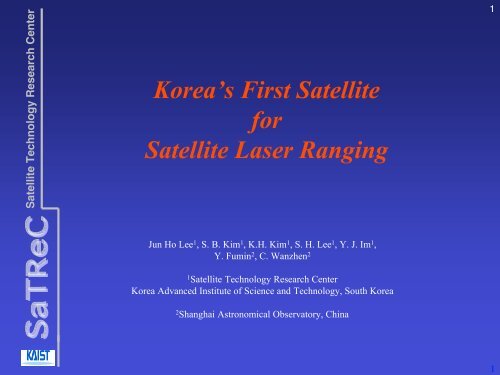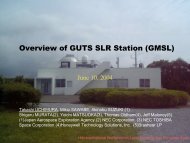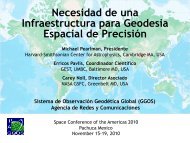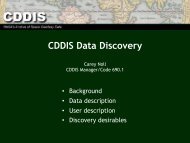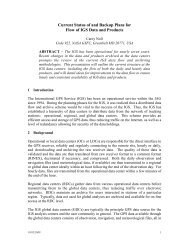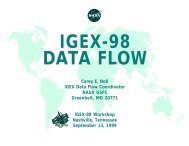Korea's First Satellite for Satellite Laser Ranging
Korea's First Satellite for Satellite Laser Ranging
Korea's First Satellite for Satellite Laser Ranging
Create successful ePaper yourself
Turn your PDF publications into a flip-book with our unique Google optimized e-Paper software.
1<br />
<strong>Satellite</strong> Technology Research Center<br />
Korea’s <strong>First</strong> <strong>Satellite</strong><br />
<strong>for</strong><br />
<strong>Satellite</strong> <strong>Laser</strong> <strong>Ranging</strong><br />
1<br />
Jun Ho Lee 1 , S. B. Kim 1 , K.H. Kim 1 , S. H. Lee 1 , Y. J. Im 1 ,<br />
Y. Fumin 2 , C. Wanzhen 2<br />
1<br />
<strong>Satellite</strong> Technology Research Center<br />
Korea Advanced Institute of Science and Technology, South Korea<br />
2<br />
Shanghai Astronomical Observatory, China
2<br />
<strong>Satellite</strong> Technology Research Center<br />
Contents<br />
• Introduction to SaTReC<br />
• KITSAT/STSAT programs<br />
• STSAT2<br />
• LRA <strong>for</strong> STSAT2<br />
• SLR <strong>for</strong> STSAT2<br />
2
3<br />
<strong>Satellite</strong> Technology Research Center<br />
q SaTReC was<br />
Introduction to SaTReC<br />
Overview<br />
¸ Founded in 1989 as Korea’s first research organization dedicated to<br />
education and research in satellite engineering, space science and remote<br />
sensing<br />
¸ Selected in 1990 as an Engineering Research Center by the Korea Science<br />
and Engineering Foundation, which marked the beginning of space activities in<br />
Korea<br />
3<br />
q SaTReC developed<br />
¸ Korea’s first two satellites: KITSAT-1, KITSAT-2<br />
¸ Korea’s first earth observation satellite: KITSAT-3 (13.5m Multi-spectral GSD)<br />
¸ Korea’s first space science satellite: STSAT-1 (Other names: KITSAT-4 or<br />
KAISTSAT-4)
4<br />
<strong>Satellite</strong> Technology Research Center<br />
Introduction to SaTReC<br />
One of three majors in Korea’ Space Deve<br />
l.<br />
SaTReC, KAIST<br />
• STSAT series development<br />
• <strong>Satellite</strong> Engineering Research<br />
• Manpower training & Education<br />
MOST, Government<br />
4<br />
• Policy & strategy maker <strong>for</strong> national<br />
space development<br />
KARI<br />
• National institute <strong>for</strong> aerospace<br />
• KOMPSAT series development<br />
• <strong>Satellite</strong> Launcher development<br />
Industry<br />
• Commercial satellites<br />
• Space market supplier
5<br />
<strong>Satellite</strong> Technology Research Center<br />
q 1989 Established<br />
Introduction to SaTReC<br />
Brief History<br />
q 1990 KITSAT-1 Initiation (Surrey Univ., U.K.)<br />
q 1992 KITSAT-1 Launch<br />
q 1993 KITSAT-2 Launch<br />
q 1995 Opened Overseas Laboratories in UCL, U.K. (Optical Camera,<br />
SAR)<br />
q 1999 KITSAT-3 Launch<br />
q 1999 SaTReCi spin-off<br />
q 2003 STSAT-1 (KITSAT4 or KAISTSAT4) Launch<br />
q 2004 STSAT-2 Development<br />
q 2005~2007 STSAT-2 Launch (Planned)<br />
5
6<br />
<strong>Satellite</strong> Technology Research Center<br />
Introduction to SaTReC<br />
Manpower<br />
6
7<br />
<strong>Satellite</strong> Technology Research Center<br />
Introduction to SaTReC<br />
Manpower<br />
7
8<br />
<strong>Satellite</strong> Technology Research Center<br />
Introduction to SaTReC<br />
Annual Budget<br />
(Unit: Million US $)<br />
8
<strong>Satellite</strong> Technology Research Center<br />
Electronics Assembly<br />
and Test Area (200 sqm)<br />
Introduction to SaTReC<br />
Facilities<br />
Attitude Control Simulator<br />
9<br />
Environment test facility<br />
KITSAT/STSAT<br />
Ground Control<br />
Clean Room <strong>for</strong> Integration &Test<br />
(cleanness : 100,000, 150 sqm)<br />
13m S/X Band<br />
+ 3m S-Band<br />
+ 1 VHF/UHF antenna<br />
9
10<br />
<strong>Satellite</strong> Technology Research Center<br />
Introduction to KITSAT/STSAT Series<br />
Korea’s Long Term Plan For Space Devel.<br />
10
11<br />
<strong>Satellite</strong> Technology Research Center<br />
Introduction to KITSAT/STSAT Series<br />
KITSAT Series<br />
11<br />
KITSAT-1 (1992)<br />
- Technology Acquisition<br />
- Manpower Training<br />
- Jointly Developed with the<br />
University of Surrey, UK<br />
KITSAT-2 (1993)<br />
- New Payloads<br />
- Use of Korean Components<br />
- Developed by SaTReC and<br />
Tested in Korea<br />
KITSAT-3 (1999)<br />
- Development of a Unique<br />
Small <strong>Satellite</strong> System<br />
- Engineering Test <strong>for</strong> Key<br />
Technologies<br />
- Advanced Payloads
12<br />
<strong>Satellite</strong> Technology Research Center<br />
Introduction to KITSAT/STSAT Series<br />
KITSAT Series<br />
12
13<br />
<strong>Satellite</strong> Technology Research Center<br />
Introduction to KITSAT/STSAT Series<br />
STSAT Series<br />
• Nano satellites<br />
• Light weight technology<br />
• Advanced attitude control<br />
13<br />
STSAT-1 (2003)<br />
STSAT-2 (2005/2007)<br />
- Development of High - Sun Observation<br />
Per<strong>for</strong>mance Micro-Sat - <strong>Satellite</strong> <strong>Laser</strong> <strong>Ranging</strong><br />
- Space Astronomy (FIMS) - Engineering & Technology<br />
- Engineering & Technology Demonstration<br />
Demonstration<br />
•IR sensor<br />
•Hyper-spectral<br />
sensor<br />
•Radiometer<br />
•SAR sensor<br />
STSAT-3(2008)~STSAT6<br />
* Detailed missions have been fixed yet.
14<br />
<strong>Satellite</strong> Technology Research Center<br />
STSAT2<br />
Mission Summary<br />
14
15<br />
<strong>Satellite</strong> Technology Research Center<br />
STSAT2<br />
Preliminary Design<br />
15
16<br />
<strong>Satellite</strong> Technology Research Center<br />
LRA <strong>for</strong> STSAT2<br />
Design<br />
• LRA (<strong>Laser</strong> Retro-reflector Array) is a payload <strong>for</strong> STSAT2, which consists of an ar<br />
ray of 9 retro-reflectors and mechanical housing. The payload might have additional<br />
single retro-reflectors or LRA with its on mechanical structures depending on the ge<br />
ometry of the STSAT2 and its operational modes.<br />
16
17<br />
<strong>Satellite</strong> Technology Research Center<br />
LRA <strong>for</strong> STSAT2<br />
Manufactured<br />
• LRA <strong>for</strong> STSAT2 was developed through the international collaboration between Sa<br />
TReC, KAIST, South Korea and Shanghai Astronomical Observatory, China.<br />
17<br />
18<br />
<strong>Satellite</strong> Technology Research Center<br />
LRA <strong>for</strong> STSAT2<br />
Optically Tested<br />
18
19<br />
<strong>Satellite</strong> Technology Research Center<br />
• No Korea SLR Stations<br />
SLR <strong>for</strong> STSAT2<br />
SLR Stations<br />
• So far we contacted China SLR Network, U.K. Herst<br />
monceus, Japan CRL.<br />
– Special thanks should go <strong>for</strong> China SLR network <strong>for</strong> their ki<br />
ndness.<br />
• We are planning to apply the ILRS service. (The lau<br />
nch date is still in doubt!)<br />
19
20<br />
<strong>Satellite</strong> Technology Research Center<br />
SLR <strong>for</strong> STSAT2<br />
Contacted SLR Stations<br />
20
21<br />
<strong>Satellite</strong> Technology Research Center<br />
SLR <strong>for</strong> STSAT2<br />
Safety Issues<br />
• A question over whether the laser could damage optical sensors<br />
on STSAT2.<br />
• In general, all remote sensing payloads have large aperture lens<br />
es that could focus the received laser power onto one pixel of a<br />
sensor with potentially damaging results.<br />
• <strong>Satellite</strong> systems potentially affected<br />
– LIST, Star tracker, Sun sensor fl damage to CCDs<br />
– Solar Panel fl damage from partial illumination or shading, l<br />
aser intensity itself does not damage solar panel.<br />
21<br />
• Worst case considered: Maximum laser power, lowest altitude,<br />
minimum attenuation
<strong>Satellite</strong> Technology Research Center<br />
SLR <strong>for</strong> STSAT2<br />
Safety Issues<br />
22<br />
• CCD breakdown voltage: 0.3 J/cm 2 , CCD noticeable morphological damage at above 0.7<br />
J/cm 2 .<br />
• Surrey carried out CCD damage experiment with a laser of 5400 times higher power than<br />
the predicted worst case. The experiment shows that the camera was not damaged even w<br />
ith that high power.<br />
Note.<br />
1. Energy from sun and laser are calculated at 532nm wavelength with 50ps of SLR laser pulse width.<br />
2. <strong>Laser</strong> ªÁæÁ : Power 50mJ with 50 ps pulse width at 0.532mm, Beam divergence=30’’, Atmospheric Transmission<br />
=0.5, Altitude=300km, Transmission coefficient of launching telescope=0.7<br />
3. Following Beam size at 300km = 1495m 2 , Energy density=33.4 mJ/m 2<br />
22
23<br />
<strong>Satellite</strong> Technology Research Center<br />
SLR <strong>for</strong> STSAT2<br />
Contact Time (Predicted)<br />
23
24<br />
<strong>Satellite</strong> Technology Research Center<br />
SLR <strong>for</strong> STSAT2<br />
Contact Time (Predicted)<br />
24
25<br />
<strong>Satellite</strong> Technology Research Center<br />
SLR <strong>for</strong> STSAT2<br />
Line of Sight or Contact ability<br />
q For communication, STSAT2 will always earth-point the ground station at Daejo<br />
n<br />
q LRA and S-band, X-band antenna are on the same plane of STSAT<br />
‡ All SLR stations around Daejon always will be in LRA’s optical field of view (60°)<br />
25
26<br />
<strong>Satellite</strong> Technology Research Center<br />
Thank You.<br />
26


